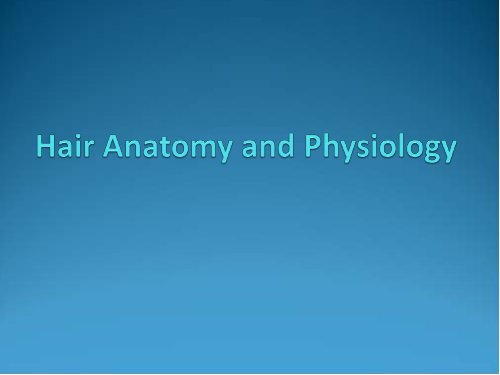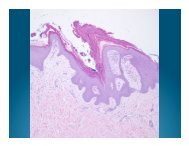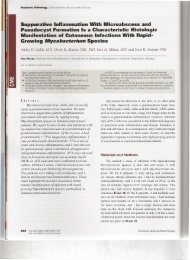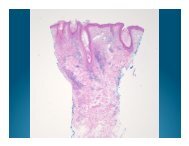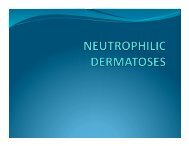Hair Anatomy and Physiology - DermpathMD.com
Hair Anatomy and Physiology - DermpathMD.com
Hair Anatomy and Physiology - DermpathMD.com
You also want an ePaper? Increase the reach of your titles
YUMPU automatically turns print PDFs into web optimized ePapers that Google loves.
Basics<br />
<strong>Hair</strong> has little remaining physiologic importance,<br />
but great psychological importance.<br />
Five million total hair follicles in the adult human,<br />
without significant racial or sexual differences<br />
Scalp has highest density, but declines with age from<br />
1135/cm 2 at birth to<br />
300-500/cm 2 in adults for a total of 100,000 follicles.
Basics<br />
Ethnic differences in hair shape are the result of<br />
differences in follicle shape.<br />
The follicle keratinizes (hardens) 1 st & molds the hair<br />
to its shape<br />
Caucasian=round to oval<br />
Black=elliptical/flattened<br />
Asian=round, also largest diameter
Embryology <strong>and</strong> Development<br />
Early formation of hair follicles depends on a very<br />
<strong>com</strong>plicated series of mesenchymal epithelial<br />
interactions that are being actively investigated.<br />
Why study these <strong>com</strong>plex interactions?<br />
One day it may be possible to induce new follicle<br />
development as a treatment for the scarring alopecias<br />
Timeline:<br />
10 Weeks: Follicle formation begins on the head<br />
(particularly eyebrows, lower <strong>and</strong> upper lip)<br />
16 weeks: Follicles develop cephalocaudally over rest of<br />
the body<br />
22 weeks: New follicle formation <strong>com</strong>plete
Embryology<br />
No hair follicles form after birth (under normal<br />
circumstances)<br />
The nonr<strong>and</strong>om symmetric distribution is probably<br />
determined by patterning genes such as hox, msx, en<br />
that were originally discovered in Drosophila<br />
The establishment of a dermal papilla (DP) is vital to the<br />
development of all hair follicles.<br />
DP is a group of specialized dermal fibroblast cells.<br />
They are derived from the embryonic mesoderm<br />
They aggregate in the dermis just below the epidermis.
Embryology<br />
Undifferentiated<br />
Epithelium:<br />
β-catenin is thought to be<br />
the first signal from the<br />
mesenchyme (dermis) to<br />
start the process<br />
β-catenin degradation is<br />
prevented by WNT signaling<br />
molecules allowing it to bind<br />
to intranuclear LEF factors<br />
(LEF=Lymphoid enhancerbinding<br />
factor)
Embryology<br />
Placode Stage:<br />
Epithelial Placode: Small<br />
collection of cells that 1 st<br />
appear in otherwise<br />
homogenous epithelium<br />
around 10 weeks in<br />
response to dermal signal<br />
Some of these signals are<br />
promoters, some inhibitors<br />
Germ Phase: (Formation<br />
of Dermal Condensate)<br />
Sonic Hedgehog protein<br />
(SHH) is thought to be a<br />
major player.
The very first stages of hair follicle embryogenesis are shown in the<br />
pictures above. At stage 0, before hair follicle development, the epidermis<br />
<strong>and</strong> dermis are uniform. At stage 1, a few dermal fibroblast-like cells<br />
aggregate below the epidermis <strong>and</strong> the epidermal cells above the<br />
aggregation be<strong>com</strong>e larger. At stage 2 the epidermal cells start<br />
proliferating <strong>and</strong> push down into the dermis following the dermal papilla<br />
cells.
Embryology<br />
Peg Phase:<br />
The dermal condensate<br />
signals the follicular<br />
epithelium (peg) to<br />
proliferate <strong>and</strong> grow down<br />
into the dermis, again SHH<br />
is implicated<br />
The dermal condensate<br />
be<strong>com</strong>es enveloped by the<br />
follicular epithelial cells <strong>and</strong><br />
the Dermal Papilla is formed
Bulbous Peg Phase:<br />
At least 7 different epithelial<br />
layers constituting the<br />
<strong>com</strong>ponents of the mature<br />
hair follicle are formed;<br />
NOTCH1 is thought to be a<br />
key factor in this<br />
differentiation.
Embryology<br />
Bulbous Peg Phase:<br />
At this time, 3 bulges<br />
appear on the follicle wall<br />
Upper forms APOCRINE<br />
gl<strong>and</strong>s in appropriate<br />
locations<br />
Middle forms SEBACEOUS<br />
gl<strong>and</strong>s<br />
Lower forms the important<br />
HAIR BULGE <strong>and</strong> is the site<br />
of arrector pili muscle<br />
attachment<br />
Melanocytes be<strong>com</strong>e<br />
interspersed among the<br />
keratinocytes
Embryology<br />
As the epidermal plug penetrates down into the<br />
dermis mesodermal cells congregate around it.<br />
The mesodermal cells develop into a fibrous follicular<br />
sheath or collagen capsule to encase the epidermal<br />
cells.
Embryology<br />
Final Follicle Formation Stage:<br />
Center of the hair peg disintegrates <strong>and</strong> keratinizes,<br />
forming a canal<br />
Lanugo hair begins to develop<br />
Shed from scalp & eyebrows at 32-36 weeks to allow<br />
terminal hair growth in these areas.<br />
Persists on the rest of the body until 4-6 months of age
1. Ectoderm<br />
2. Mesoderm
<strong>Anatomy</strong><br />
<strong>Hair</strong> Types:<br />
Terminal<br />
Large<br />
Pigmented<br />
Medullated<br />
1-100cm long<br />
60um diameter<br />
Lanugo<br />
Fetal<br />
nonmedullated<br />
Vellus<br />
Small<br />
little to no pigment<br />
Nonmedullated<br />
ulb<br />
Critical line<br />
of Auber<br />
Dermal<br />
papilla<br />
Infundibulum Isthmus<br />
Inner root<br />
sheath<br />
Outer root<br />
sheath<br />
Bulge<br />
region
Longitudinal <strong>Anatomy</strong> (surface<br />
to deep)<br />
Dynamic, has both<br />
permanent <strong>and</strong> transient<br />
features<br />
PERMANENT:<br />
Infundibulum<br />
Epidermal surface to<br />
opening of the sebaceous<br />
gl<strong>and</strong>.<br />
Forms a stable conduit for<br />
the hair shaft<br />
May see Demodex, yeast,<br />
etc. here
Longitudinal <strong>Anatomy</strong> (surface to<br />
deep)<br />
Isthmus<br />
Located between the<br />
sebaceous gl<strong>and</strong> <strong>and</strong> the<br />
<strong>Hair</strong> Bulge.<br />
Anchors the hair shaft to<br />
the ORS during catagen
Longitudinal <strong>Anatomy</strong> (surface<br />
to deep)<br />
TRANSIENT:<br />
Suprabulbar Area or Lower Follicle<br />
Located from Bulge to <strong>Hair</strong> bulb<br />
<strong>Hair</strong> Bulb<br />
Contains the matrix cells which<br />
envelope the dermal papilla<br />
Matrix cells divide very rapidly, 2 nd<br />
only to hematopoetic cells<br />
They are the source of epidermal cells<br />
Differentiate <strong>and</strong> be<strong>com</strong>e keratinized to<br />
form<br />
<strong>Hair</strong> cortex<br />
Surrounding hair cuticle of hair<br />
shaft<br />
Inner root sheath (IRS)<br />
Outer root sheath (ORS)
Longitudinal <strong>Anatomy</strong> (surface to deep)<br />
Transient<br />
<strong>Hair</strong> Bulb<br />
Critical Line of Auber<br />
widest diameter of bulb<br />
highest mitotic activity<br />
Dermal Papilla<br />
Dictates the embryonic generation of a hair follicle<br />
Modifies the extent of proliferation <strong>and</strong> differentiation of the epithelial hair<br />
germ, <strong>and</strong> thus controls the size of the hair follicle<br />
Derived from the dermis mesenchyme<br />
Consists of small group of fibroblast cells derived from the mesoderm<br />
Basement membrane or glassy membrane separates the DP cells from the hair<br />
fiber/sheath cells.<br />
The bigger the DP the thicker the hair fiber
Cross Sectional <strong>Anatomy</strong> (center to<br />
periphery)<br />
Medulla<br />
Found only in large terminal<br />
hairs<br />
Generated from matrix cells<br />
at tip of dermal papilla<br />
Appears amorphous since it<br />
only partially keratinizes<br />
Contains CITRULLINE (like<br />
IRS)
Cross Sectional <strong>Anatomy</strong> (center to<br />
periphery)<br />
Cortex<br />
Thick layer of elongated<br />
keratinocytes formed from<br />
matrix cells<br />
Makes up the bulk of the<br />
hair shaft<br />
Contains melanin granules<br />
<strong>Hair</strong> Cuticle<br />
Single outer layer of<br />
imbricated keratinocytes<br />
(like roof tiles) that interlock<br />
with the IRS Cuticle
Cross Sectional <strong>Anatomy</strong> (center to<br />
periphery)<br />
Inner Root Sheath (IRS)<br />
Made up of 3 layers<br />
Does NOT contain melanin<br />
Formed from matrix cells (at periphery of follicle) in<br />
pace with the hair shaft<br />
It dictates the shape of the hair since it hardens<br />
(keratinizes) first<br />
IRS cells are shed into the infundibulum as the hair<br />
shaft grows<br />
Products of the sebaceous gl<strong>and</strong> help break down the<br />
IRS<br />
Contains CITRULLINE (Like Medulla)
Henle’s
Huxley’s <strong>and</strong> cuticle
Cross Sectional <strong>Anatomy</strong> (center to<br />
periphery)<br />
Layers of IRS<br />
IRS Cuticle (Inner)<br />
Huxley’s Layer (Middle) 3-4 cells thick<br />
Henle’s Layer (Outer) One cell layer thick. FIRST TO<br />
BE KERATINIZED!<br />
Contain Keratins 1/10 (like upper layers of epidermis)<br />
Keratinization order<br />
(1) Henle’s<br />
(2) Cuticle of IRS/<strong>Hair</strong><br />
(3)Huxley’s
Cross Sectional <strong>Anatomy</strong> (center to<br />
periphery)<br />
Outer Root Sheath (ORS)<br />
Unclear if this is derived from the Matrix or not<br />
AREA WHERE MOST BCC’s ARISE<br />
<strong>Hair</strong> casts form from this layer<br />
Contains the <strong>Hair</strong> Bulge<br />
This area consists of a cluster of biochemically distinct cells that<br />
are the slowest cycling <strong>and</strong> longest-lived of the follicular unit.<br />
Express K19 which is a stem cell marker<br />
Believed to be source of cells to form the matrix with each new<br />
follicular cycle.<br />
Reservoir for melanocytes, Langerhans cells, Merkel cells,<br />
epidermal cells that repopulate the epidermis after injury<br />
K5/14 (like basal layer) & K6/16 (proliferating keratins)<br />
present
Cross Sectional <strong>Anatomy</strong> (center to<br />
periphery)<br />
Glassy or Vitreous Membrane:<br />
A-cellular basement membrane bounding the entire<br />
follicle<br />
Be<strong>com</strong>es corrugated in catagen, therefore, can be<br />
used as marker of this phase<br />
Fibrous Root Sheath<br />
Outermost layer<br />
continuous with the dermis
<strong>Hair</strong> Keratinization<br />
Cortical keratins<br />
classified as “hard” keratins as opposed to epidermal<br />
“soft” keratins<br />
Have a higher Cysteine content which allows for more<br />
disulfide bonds <strong>and</strong> greater durability<br />
These bonds are broken <strong>and</strong> reestablished by perms<br />
<strong>and</strong> straighteners (alkali substances)<br />
Cortical Keratins are divided into 2 types:<br />
Ha = Acidic 1-8 (Chromosome 17)<br />
Hb = Basic 1-6 (Chromosome 12): Monilethrix #6<br />
Occur in pairs with a highly conserved alpha helical<br />
domain like epidermal keratins
<strong>Hair</strong> Keratinization<br />
ORS <strong>and</strong> <strong>Hair</strong> Shaft undergo Tricholemmal<br />
keratinization without the appearance of a granular<br />
layer<br />
IRS keratinizes in a manner similar to the epidermis<br />
via the formation of Trichohyalin granules which are<br />
categorized as soft keratins
Cysts<br />
Epidermal inclusion cyst<br />
Derived from the infundibulum<br />
Will see trichohyalin granules<br />
Soft keratin like epidermis<br />
Tricholemmal cyst<br />
Derived from the isthmus<br />
Will not see trichohyalin granules<br />
Hard keratin like hair <strong>and</strong> ORS
<strong>Hair</strong> Growth Cycle<br />
All animals (except Merino sheep & poodles)<br />
have hair that cycles between active (Anagen) &<br />
resting (Telogen) states<br />
Human hair exhibits mosaic growth except for<br />
lanugo hair in early life<br />
<strong>Hair</strong> length is dependent on length of Anagen<br />
Scalp hair has the longest anagen phase (3-7 years)<br />
eyebrows have the shortest Anagen phase
1. Anagen<br />
2. Catagen<br />
3. Telogen
<strong>Hair</strong> Growth Cycle<br />
Anagen<br />
Growth phase<br />
The root of the hair is<br />
embedded deep in the<br />
dermis/subcutis<br />
Large <strong>and</strong> has pigment<br />
Lasts for 3-6 years
<strong>Hair</strong> Growth Cycle<br />
Catagen<br />
Regression phase<br />
<strong>Hair</strong> does not grow<br />
Moves closer towards<br />
the epidermis<br />
Takes the form of a club<br />
hair<br />
Lasts about 2-3 weeks
<strong>Hair</strong> Growth Cycle<br />
Telogen<br />
Resting phase<br />
<strong>Hair</strong> can now be considered<br />
dead<br />
It will fall out<br />
Gets smaller <strong>and</strong> lighter<br />
Moves towards the epidermis<br />
Pushed out by new hair<br />
growing in<br />
Lasts 3 months
<strong>Hair</strong> Growth Cycle<br />
ANAGEN:<br />
80-90% of scalp hair in growing phase<br />
Unclear what physiologic events stimulate growth<br />
assumed that factors from the dermal papilla regulate<br />
anagen onset<br />
Keratinocyte Growth Factor (KGF or FGF-7) is<br />
implicated<br />
<strong>com</strong>plicated process involving redundant signals<br />
Cyclosporin, Minoxidil, PTH-related peptide &<br />
estrogen receptor antagonists induce anagen in mice
Substance Site of action Effect on hair growth<br />
Basic fibroblast growth factor (bFGF) Dermal papilla Increase<br />
Platelet-derived growth factor (PDGF) Dermal papilla Increase<br />
Transforming growth factor beta (TGF- beta) Dermal papilla Decrease<br />
Hepatocyte Growth Factor (HGF) Dermal papilla / <strong>Hair</strong><br />
matrix<br />
Macrophage Stimulating Protein (MSP) Dermal papilla / <strong>Hair</strong><br />
matrix<br />
Increase<br />
Increase<br />
Interleukin 1-alpha (IL-1- alpha) <strong>Hair</strong> matrix Decrease<br />
Fibroblast growth factor type 5 (FGF5) <strong>Hair</strong> matrix Decrease<br />
Epidermal growth factor (EGF) <strong>Hair</strong> matrix Decrease<br />
Keratinocyte growth factor (KGF) <strong>Hair</strong> matrix Increase<br />
Insulin-like growth factor I (IGF-I) <strong>Hair</strong> matrix Increase<br />
Substance P Unknown Increase<br />
Parathyroid hormone (PTH) Unknown Decrease<br />
Estrogens Unknown Decrease
<strong>Hair</strong> Growth Cycle<br />
Six Stages of Anagen<br />
1. Stem cells in Bulge of<br />
ORS divide to produce<br />
secondary hair germ which<br />
be<strong>com</strong>es the matrix<br />
2. Germ cells proliferate<br />
downward enclosing the<br />
dermal papilla<br />
3. Matrix cells differentiate<br />
forming the Cortex <strong>and</strong> IRS.<br />
These push upward as the<br />
hair bulb descends into the<br />
subcutaneous fat
<strong>Hair</strong> Growth Cycle<br />
Six stages of Anagen<br />
4. Melanocytes send<br />
dendrites into the hair bulb<br />
<strong>and</strong> begin secreting melanin<br />
into keratinocytes<br />
5. Tip of hair emerges from<br />
the IRS<br />
6. <strong>Hair</strong> emerges from skin.<br />
Continues growing until<br />
Catagen<br />
FGF-5 may be signal to end<br />
Anagen<br />
if absent, catagen will still<br />
occur, but much later
<strong>Hair</strong> Growth Cycle<br />
CATAGEN<br />
Lasts only 2-3 weeks<br />
Only 1% of follicles in this stage<br />
Mitosis ceases in the matrix <strong>and</strong> the cells keratinize<br />
forming a club hair<br />
Apoptosis occurs<br />
Melanocytes stop producing pigment<br />
Melanocytes withdraw their dendrites so the club end<br />
of the hair is NOT pigmented<br />
The Suprabulbar area collapses like an accordion <strong>and</strong><br />
involutes while the vitreous membrane be<strong>com</strong>es thick<br />
<strong>and</strong> corrugated
<strong>Hair</strong> Growth Cycle<br />
CATGEN<br />
IRS disintegrates & the ORS forms a sac from which<br />
the next generation hair germ will form<br />
The dermal papilla follows the collapsing bulb <strong>and</strong><br />
<strong>com</strong>es to rest just below the Bulge.<br />
If this fails to happen no more hairs will be formed.<br />
This is seen in the mouse hairless gene <strong>and</strong> in a<br />
Pakistani family (Atrichia with Papular Lesions)
<strong>Hair</strong> Growth Cycle<br />
TELOGEN<br />
Period of <strong>com</strong>plete inactivity lasting about 100 days (3<br />
months) in the scalp<br />
5-10% of follicles<br />
Scalp loses 100-150 telogen hairs a day, which is only<br />
a small percentage of the total # of hairs in this phase.<br />
Club <strong>Hair</strong> either falls out during telogen or is pushed<br />
out by new hair growth during the next anagen phase.
<strong>Hair</strong> Growth Cycle<br />
EXOGEN<br />
There is speculation that hair shedding might be an<br />
active process<br />
For example, if 10% of scalp hairs (~10,000) are in<br />
telogen, then why does one only lose 100 hairs a day<br />
<strong>Hair</strong> shedding might involve release by Desmoglein 3<br />
which is believed to anchor the club hair during<br />
Telogen
Loose anagen hair syndrome<br />
Findings: ruffled cuticles <strong>and</strong> deformed hair bulbs
Control of <strong>Hair</strong> Growth<br />
Scalp hair grows at 1cm/month or 0.34mm/day<br />
Plucking telogen hairs seems to advance the<br />
onset of anagen<br />
Shaving has no effect on hair growth or diameter<br />
Differences in maximal achievable scalp hair<br />
length are the result of different anagen lengths<br />
Follicles are inherently programmed to cycle<br />
There are other control mechanisms, especially<br />
via the endocrine system
Control of <strong>Hair</strong> Growth<br />
Hormones<br />
Androgens<br />
THE MOST IMPORTANT hormonal regulators<br />
Act through receptors in the dermal papilla<br />
Increases the length of anagen, diameter, <strong>and</strong> growth<br />
rate in susceptible follicles<br />
Paradoxically cause shorter anagen time,<br />
miniaturization, <strong>and</strong> slower growth in areas such as<br />
the scalp.<br />
Axillary & Pubic hair respond to testosterone, rest of<br />
body hair only responds to DHT made by 5-alpha<br />
reductase.
Control of <strong>Hair</strong> Growth<br />
Hormones<br />
Androgens<br />
5-alpha reductase deficiency have axillary & pubic, but<br />
no body hair, balding or prostatic hypertrophy)<br />
5αR Type I: Sebaceous gl<strong>and</strong>s<br />
Type II: Prostate <strong>and</strong> dermal papilla<br />
Puberty<br />
Pubic hair responds 1 st<br />
Axillary & beard hair growth ~2 years later.<br />
Adult pattern not fully <strong>com</strong>plete until 4 th decade
Control of <strong>Hair</strong> Growth<br />
Hormones<br />
Estrogens<br />
Prolongs anagen but decreases the growth rate.<br />
Responsible for the post-partum telogen effluvium<br />
Thyroxine<br />
Advances onset of anagen<br />
increases growth rate.<br />
Excesses can be stressful <strong>and</strong> lead to telogen<br />
effluvium.<br />
Deficiency can do the same in addition to slowing<br />
growth rate.


